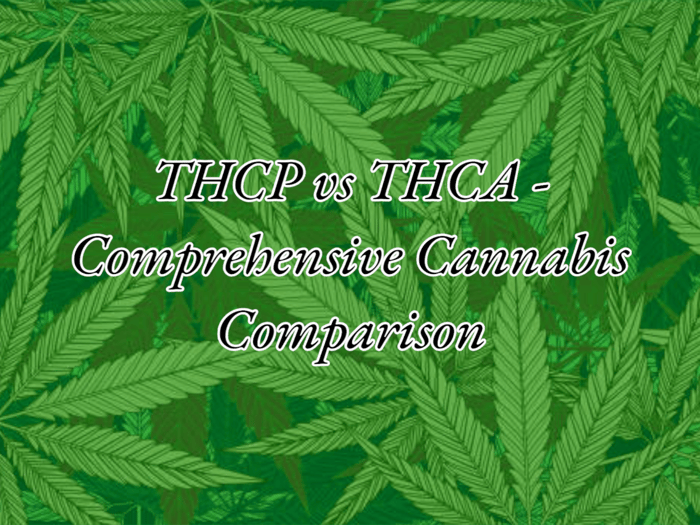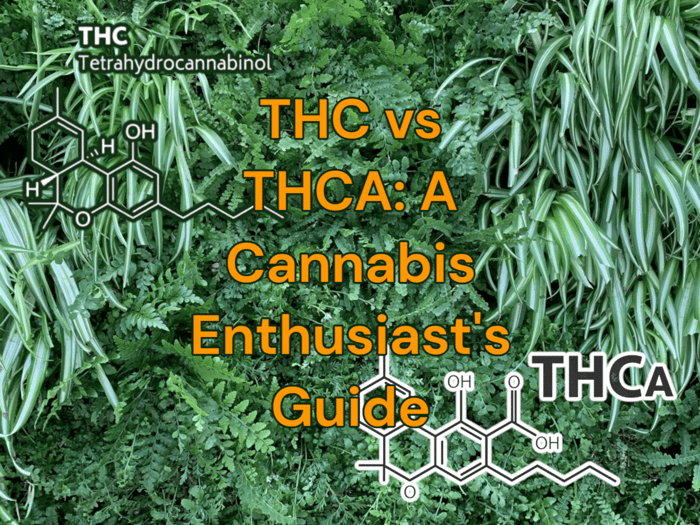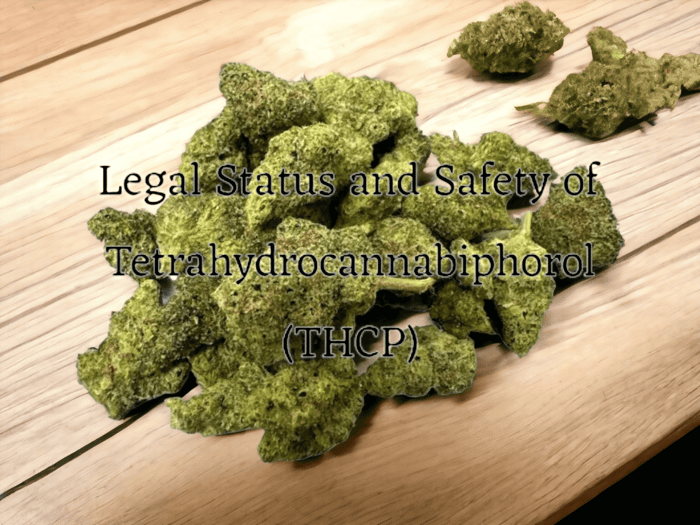
THCA vs THCP: A Comprehensive Comparison of Cannabis's Pioneering Cannabinoids
A Closer Look at Cannabinoids
THCP vs THCA: Cannabinoids are naturally-occurring compounds found in the Cannabis plant. These chemicals interact with cannabinoid receptors in the human body, notably in the endocannabinoid system, to produce varied physiological and psychological effects.
Common Cannabinoids in Cannabis
The Cannabis plant hosts over a hundred different types of cannabinoids, with the most prominent being Delta-9-tetrahydrocannabinol (THC) and Cannabidiol (CBD). Other cannabinoids include Cannabinol (CBN), Cannabigerol (CBG), and Cannabichromene (CBC), each with its unique biochemical effects.
Pioneering Cannabinoids: THCA and THC-P
This article will focus on two specific cannabinoids: Tetrahydrocannabinolic Acid (THCA) and Tetrahydrocannabiphorol (THCP). Both show promise in contributing to our understanding of the cannabis universe and its potential health benefits.
Health and Wellness Industry's Interest in THCA and THCP
The health and wellness industry has shown a deep interest in cannabinoids, including THCA and THCP, due to their potential therapeutic effects. Preliminary research indicates that these cannabinoids could have anti-inflammatory, neuroprotective, and anti-emetic properties, among others. This extensive range of potential therapeutic effects underscores the growing importance of THCA and THCP in health and wellness applications.
Overview of THCA: Its Structure, Effects and Potential Health Benefits
Known to many as the progenitor of those cannabis compounds notorious for their psychoactive effects (THC), Tetrahydrocannabinolic Acid (THCA) is a cannabinoid in its own right. Distinguished by its structure, known biological effects, and potential health benefits, THCA is a prominent constituent of many raw cannabis strains.
The Structure of THCA
THCA's defining structural feature is its carboxylic acid group, which takes the form of an extra carbon atom (C), oxygen atom (O), and two hydrogen atoms (H) compared with the structure of THC, its psychoactive collection. This additional carboxylic group means that THCA does not induce the high commonly associated with cannabis consumption until decarboxylation occurs. This process, often facilitated by heat, removes the acid group and converts THCA into intoxicating THC.
Effects of THCA on the Human Body
The body of evidence regarding THCA's physiological effects is growing but remains comparatively preliminary. Among these, a noteworthy observation is that THCA does not interact with the body's endocannabinoid system in the same way as THC, primarily because THCA does not bind well to cannabinoid receptors. Instead, it might work via interactions with other receptors and pathways, however, further research is needed to clarify these possibilities.
Potential Health Benefits of THCA
Emerging scientific research is exploring the therapeutic benefits of THCA. Some preclinical studies suggest that THCA could potentially be a powerful anti-inflammatory agent and may even possess neuroprotective properties. Further investigation indicated potential antiemetic (anti-nausea) and antiproliferative benefits, the latter suggesting possible use in supporting treatment of certain cancers. However, these findings are preliminary and require further validation through rigorous clinical trials.
Possible Drawbacks or Side Effects of THCA
Detailed information on THCA's potential side effects is limited due to the early stages of research. However, it is known that exposure to heat leads to the decarboxylation of THCA into THC, which could inadvertently lead to psychoactive effects if not properly managed. Otherwise, as an unactivated cannabinoid, THCA is generally considered non-intoxicating and safe for adult consumption. Nonetheless, always consult healthcare providers when introducing new substances, even natural ones, into a wellness regimen.
An Overview of THCP: Structure, Effects, and Potential Health Benefits
As with all cannabinoids, the properties of THC, THCA, and THCP are wildly different and offer a wealth of variation in their potential impacts on the human body. Here, we delve into the intricate aspects of THCP – exploring its structure, effects, potential health benefits, and possible drawbacks.
Structure of THCP: Going Deeper
The structure of cannabinoids has significant implications for how they interact with the human body. THCP, or tetrahydrocannabiphorol, stands out due to its unique molecular structure. Containing a seven-link side alkyl chain, THCP has a stronger efficacy when binding to the CB1 receptor of the endocannabinoid system compared to THC. This increased binding affinity ultimately contributes to the potency and effects of THCP.
Effects of THCP on the Human Body
The discovery of THCP added another potent compound to the ongoing cannabis research. It was found that THCP may have a binding affinity thirty times stronger than THC when interacting with the CB1 receptor. This not only denotes a potentially stronger psychoactive effect but also enhanced therapeutic benefits. However, the full range of effects of THCP on the human body remains under investigation.
Unearthing the Potential Health Benefits of THCP
While research into the potential health benefits of THCP is still in its early stages, preliminary findings suggest a series of benefits similar to THC - but potentially more profound due to its superior binding affinity to CB1 receptors. The indications include pain relief, anti-inflammatory effects, and appetite stimulation. Further study is required to fully understand and harness the potential therapeutic aspects of this cannabinoid.
Considering the Possible Drawbacks of THCP
Like every compound, THCP is not without its potential drawbacks and side effects. A significant one is its strong psychoactive potency, which could negatively impact mental health if misused. Scientists have also pointed out the need for comprehensive toxicological studies to understand any potential adverse effects better. Additionally, concerns have been raised about the challenges of detecting THCP in biological samples, which could complicate its regulation and use.
Differences between THCA and THCP
While both THCA and THCP are active components of cannabis, the two compounds vary in various ways. These differences include their molecular structure, impacts on the human body, health benefits, and potential adverse effects.
Differences in Molecular Structure
THCA and THCP are cannabinoid acids found in the raw cannabis plant. The primary contrast in the molecular structure between the two lies in their alkyl side chain. THCA, like most common cannabinoids, has a pentyl side chain with five carbon atoms. On the contrary, THCP displays a heptyl side chain, which has seven carbon atoms. This unique structural characteristic may influence its binding affinity in the body's endocannabinoid system.
Varied Effects on the Human Body
THCP is highly potent due to its extended alkyl chain, demonstrating a 33-fold higher affinity for CB1 receptors than ordinary THC. As a result, its psychoactive effects can be far more potent than those of THC and THCA. Despite its non-psychoactive properties, THCA interacts with the body's endocannabinoid system, potentially aiding various physiological functions.
Comparison of Health Benefits
Both cannabinoids manifest potential health benefits, although they function differently due to their unique molecular structures. THCA has demonstrated anti-inflammatory and neuroprotective properties and can potentially aid in managing conditions such as arthritis, neurodegenerative diseases, and nausea. It may also have potential as an antiproliferative and antiepileptic agent.
Despite the limited research available on THCP, preliminary studies suggest it may offer potential therapeutic benefits. This potent cannabinoid has indicated potential anti-inflammatory and analgesic effects corresponding to its binding affinity towards CB1 and CB2 receptors in the endocannabinoid system.
Possible Adverse Effects of Each and How They Differ
THCA is generally considered safe and non-psychoactive. However, when heated or aged, it can degrade into THC, leading to psychoactive effects. This process, known as decarboxylation, occurs when cannabis is smoked or baked into edibles.
As for THCP, its increased potency and affinity for the CB1 receptor could potentially induce intense psychoactive effects. However, further research is required to fully understand its safety profile and possible side effects.
Research Evidence on the Effects and Benefits of THCA and THCP
Understanding the effects and benefits of THCA and THCP depend on a detailed examination of significant research studies conducted on these two pioneering cannabinoids.
Overview of Key Research Studies on THCA
Much of what we know about the properties, effects, and potential benefits of THCA come from a number of groundbreaking studies. For instance, a study published in the British Journal of Pharmacology hinted at the anti-inflammatory qualities of THCA, pointing out how it could potentially inhibit the enzymes associated with inflammation source.
Another study published in the Journal of Chromatography A explored THCA's antiproliferative capabilities. The research discovered that this cannabinoid might stop the proliferation of prostate cancer cells source.
Impacts of THCA Found in These Studies
The effects of THCA are largely rooted in its anti-inflammatory and antiproliferative capabilities. It potentially helps in reducing inflammation, which opens up possibilities for it to be considered in the treatment of diseases like arthritis and lupus. The potentials of its antiproliferative properties are also not lost – the ability to inhibit the proliferation of cancer cells can make it a potential player in cancer treatment.
Summary of Important Research Studies on THC-P
Research studies on THC-P, given its recent discovery, are few. Nonetheless, one of the most significant researches underlining the importance of THC-P was published in Scientific Reports. The study investigated the properties of THCP and found it to have a much stronger binding affinity to the cannabinoid receptor CB1 than THC source.
Impacts of THC-P Based on These Studies
The impact of THC-P, as revealed by the Scientific Reports study, could be monumentous for the field of medicinal cannabis. Its enhanced binding affinity to the CB1 receptor could intensify the potency of cannabis effects, which could be beneficial for therapeutic applications where a higher dosage of cannabinoids is required.
Legal Status of THCA and THC-P Across the Globe
Beyond the recognized therapeutic potential, the legal restrictions surrounding cannabinoids like THCA and THC-P have been the subject of intense debate and legislative scrutiny in various jurisdictions. The status is often nuanced, depending on interpretations of the law, chemical composition, and the specific regulations in each country or region.
Legal Position of THCA Worldwide
THCA, or tetrahydrocannabinolic acid, is a non-psychoactive cannabinoid found in raw and unheated cannabis plants. Being viewed as a precursor to THC— the psychoactive compound responsible for the 'high' effect of cannabis— the legal status of THCA is often tangled with that of THC.
In regions like the United States, THCA is not scheduled under the Controlled Substances Act, making it legal on a federal level. Nonetheless, specific state laws might differ, and interpretation varies, raising some ambiguity. In Canada, THCA is not listed under the Controlled Drugs and Substances Act, and is therefore viewed as legal. In the European Union, the legislations tend to revolve around THC content, with many jurisdictions not explicitly defining the legal parameters around THCA.
Legal Status of THC-P Globally
THC-P, or tetrahydrocannabiphorol, is a relatively newly discovered compound, with significantly higher potency than THC. Its legal status is a grey area across the globe, primarily due to limited research and the absence of a specific classification. Countries that base their cannabis regulations solely on THC content might implicitly include THC-P, given its structurally similar nature. However, in the absence of explicit regulations, it remains a topic open to interpretation.
Differences in Legality of THCA and THC-P
Highlighting differences in the legal status of THCA and THC-P is challenging due to the somewhat vague regulatory landscape. Both compounds are less known and understood, compared to THC or CBD. As a result, many legislations do not directly address these lesser-known cannabinoids. Complicating matters further is the fact that THC-P is a very recent discovery with limited research, leaving significant unknowns about its properties and effects, which in turn feeds into its shadowy legal status.
Concluding Remarks and Future Research Prospects on THCA and THC-P
Research dedicated towards understanding the role and potential of cannabis's pioneering cannabinoids, THCA and THC-P, has initiated several new conversations about their implications for health and wellness. However, certain questions remain open and the collective body of research is yet evolving.
Existing Research Scope about the Role of THCA and THC-P
The discovery of THC-P has expanded the arena of cannabinoids research. Investigations have begun to reveal their unique impacts on the body's endocannabinoid system. Furthermore, numerous studies have delved into the multifaceted roles of THCA, providing insights into its potential application in the treatment of numerous disorders.
Promising Directions for Future Research on THCA and THC-P
The field of cannabinoids research presents a plethora of possibilities waiting to be explored. Further studies must elaborate upon the therapeutic potential of both THCA and THC-P, through clinical trials to determine their efficacy and safety profiles. Additionally, research should also aim to acquire a deeper understanding of these cannabinoids' interaction with the endocannabinoid system.
Pending Inquiries Surrounding THCA and THC-P
Despite the breadth of research on THCA and our initial understanding of THC-P, several questions remain unresolved. The precise mechanisms behind their action, the potential for interactions with other cannabinoids, and the scope of their therapeutic application need further investigation. The role of THCA as a prodrug to THC and its implications also need clarification. For THCP, the factors governing its potency and its comprehensive physiological effects are yet to be completely understood.
The Role of These Cannabinoids in Health Promotion and Disease Management
THCA and THC-P are critical components of the Cannabis plant, capable of affecting the body's endocannabinoid system. As our understanding of these cannabinoids continues to grow, so will our ability to exploit their potential benefits. They have shown promise across various health domains, from inflammation and pain management to neuroprotection and more. The future of these cannabinoids holds immense potential for health and wellness.




